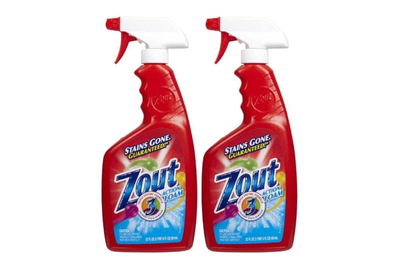
Pit Stains on Your White Tee? Don’t Sweat It. We Can Help.
We’ve added a few of our laundry detergent and stain remover picks to this article.
Classic, cool, and … yellow under the armpits?
Though a great white T-shirt is an effortless wardrobe staple, keeping it looking fresh over the long haul isn’t always easy. But with a little know-how and the right arsenal of cleaning products, it’s possible to revive even the dingiest shirts in your drawer.
Read on to learn how to bring old, yellowed shirts back from the dead—and make sure that new, pristine ones stay that way.
What causes pit stains, anyway?
You can stop blaming yourself: Those unsightly yellow stains on your white tees are not evidence of poor hygiene or excessive perspiration. They’re the result of a chemical reaction that occurs when aluminum—an active ingredient in antiperspirants—combines with the proteins in underarm sweat.
The simplest way to avoid this, ahem, pitfall, is to swap out your antiperspirant for an aluminum-free deodorant (which controls odor but not perspiration), or to go au naturel. But if that switch doesn’t appeal to you, fear not: You have plenty of other options.
Protecting your white T-shirts
Stop dillydallying
Don’t let dirty white tees languish in the laundry basket; the longer you wait, the more likely it is that stains will set and be difficult to remove. Staff writer Andrea Barnes, Wirecutter’s in-house laundry expert, recommends washing garments (especially badly stained ones) within one week of wear.
Begin by pretreating any discolored areas with a stain remover or liquid laundry detergent. For this project, Andrea likes Zout or Tide Free & Gentle Liquid Laundry Detergent. Apply it as soon as you can—ideally, right after the stain occurs—according to its instructions. The longer the treatment has to penetrate, the better, but some stain removers require washing garments within 15 minutes to prevent fabric damage.
Before tossing your laundry in the machine, be sure to separate lights from darks—darker garments can release dyes during washing that can transfer onto your whites. (In particular, watch out for reds and anything dark or colorful that hasn’t been washed yet; I say this from bitter personal experience.)
For maximum cleaning power, use a high-quality detergent—it does make a difference. For pit stains, Andrea recommends Tide Ultra Oxi Powder Laundry Detergent, Tide Free & Gentle Liquid Laundry Detergent, or Persil Original Liquid Detergent Everyday Clean. All three are picks in our guide to the best laundry detergent and top performers in our stain-removal tests.
This enzymatic stain remover effectively removes a variety of food stains, but it falls short when removing makeup and dyes.
Select the right cycle
Always check your garment’s care label—and consider its material and fit—before selecting your wash cycle. When you’re washing sweat stains, it’s best to select the warmest water possible for your item, as warm water breaks down body oils better than cold. In our personal experience with white tees, a warm wash strikes the right balance of getting the job done without running the risk of shrinking garments. (Just a heads-up: In our tests, we have found that new, all-cotton T-shirts—even if they’re preshrunk—shrink by about 3% after the first laundering; a good deal of that is caused by the heat of the dryer rather than by the wash, but we avoid scalding-hot water anyway to err on the side of caution.)
You may want to put your shirt in the dryer after washing it. We recommend making sure stains are completely gone first; the high heat of tumble drying tends to set any stains, making them harder (or even impossible) to get out. For anything that’s been heavily soiled, air-drying is the smarter bet—you can avoid unwittingly locking in any lingering stains, and air-drying is easier on fabrics.
Restoring your white T-shirts
Bring back the brightness
To give white tees a boost, use a product containing oxygen bleach in your regular wash cycle. We’re fans of Tide Ultra Oxi Powder Laundry Detergent and Clorox 2 Stain Remover & Color Brightener—both of which contain oxygen bleach as a whitening agent (sodium percarbonate in Tide Ultra Oxi Powder and hydrogen peroxide in the Clorox stain remover). Oxygen bleach is less harsh on fabrics. It’s also color-safe, more eco-friendly, and gentler on skin.
For even better whitening and brightening, dissolve powdered oxygen bleach according to the product’s instructions into a basin-full of the warmest water your garment can tolerate (we like to bathe cotton tees as we would ourselves, in the hottest water from the tub faucet), then soak the garment—overnight if possible. This is most successful when given ample time to work—8 or more hours—so try to plan ahead accordingly.
Andrea used this method to revive months-old stained white T-shirts while testing stain removers. (Tide Ultra Oxi Powder Laundry Detergent produced the best results. If you prefer a fragrance-free detergent for the job, Dirty Labs Bio Enzyme Laundry Booster will work, though your items might require a longer soak.)
In the event that your shirt is still beyond saving, deputy editor Annemarie Conte offers a final piece of advice: “Tie-dye it. It’s a great second life for a white T-shirt.” (Psst: We found the best tie-dye kit.)
Our favorite powder laundry detergent contains stain-busting enzymes and sodium percarbonate (an oxygen bleach), which makes it best for dye- and pigment-based stains.
This article was edited by Ingela Ratledge Amundson and Jennifer Hunter.
Mentioned above
- A white T-shirt is the unsung hero of many outfits, and we found four different high-quality, stylish shirts to suit a variety of budgets and sizes.The Best Men’s White T-Shirts
- We tested more than 20 stain removers on fresh and set-in stains, and Amodex Ink & Stain Remover is the most well-rounded choice to have on hand.The Best Stain Removers
- We tested dozens of laundry detergents and found that Tide Ultra Oxi Powder and Tide Free & Gentle Liquid tackled the widest range of stains with ease.The Best Laundry Detergent
- The right tools can keep your clothing looking better for longer. Here’s what you need to wash, dry, and spruce up your favorites.11 Cheap(ish) Laundry Aids to Help Your Clothes Look Better and Last Longer
- Make gorgeous, vibrant tie-dye shirts with our top pick, the Tulip One-Step Tie-Dye Kit.The Best Tie-Dye Kits
Further reading
The Numi Undershirt Will Block Your Sweat. Too Bad It’s Uncomfortable, Unflattering, and Expensive.
by Zoe Vanderweide
Numi’s undershirt promises to block sweat and prevent pit stains—it does the job, but not comfortably.
How Can I Prevent Discoloration in Sheets?
by Leigh Krietsch Boerner
Can discoloration of sheets be prevented? Whether or not your linens can be saved depends on the cause.
How to Set the Table for Your First Dinner Party
by Michael Sullivan
Hosting your first dinner party may seem daunting, but we've found all the best items you’ll need to throw a casual, stress-free dinner.
Wirecutter Picks to Help You Throw an Unforgettable Barbecue
by Wirecutter Staff
Everything you’ll need to host a memorable barbecue this summer, from our favorite grilling gear to bug-battling essentials.





